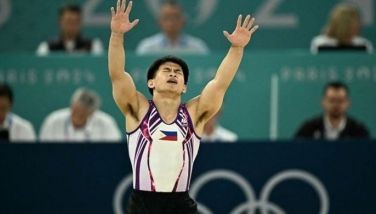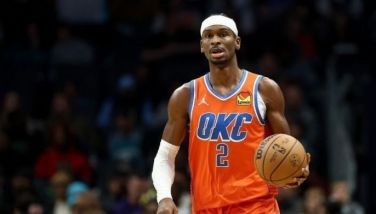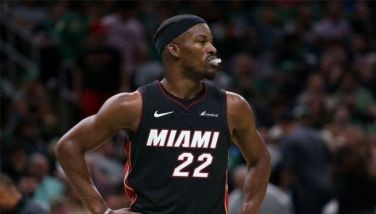April in Paris... for a marathon?
Manila, Philippines - Who goes to Paris in April to run in a marathon? You there to enjoy the springtime... to fall in love... but to run?
Well, some 40,000 people did go this April to Paris to run a marathon, including a contingent of a dozen Filipinos. It really isn't as crazy as it sounds. After all, seasoned travelers have always said that the best way to see a city is not on board a tour bus but on foot.
The advice covers not just cities but cultural landmarks as large and monumental as the Great Wall of China. Last year, I was with a group of Filipinos who participated in the Great Wall Marathon with 2,000 others. The experience provides a feel of the Great Wall that cannot be had by riding the cable cars from the touristy portions of the wall.
April is a good time to be in Paris. The spring weather finds Parisians in good spirits, hanging out in cafes. It is also most conducive to a good run around the city. We may have even brought the sunshine to Paris all the way from Manila. When we arrived on April 5 the weather was a cold 15 degrees Celsius. By the time the big day rolled around on April 10 the sun was up and bright and it was a warm 23 degrees!
It is a good idea to acclimatize before a run, and get over jet lag if you have to travel across several time zones. But more important is to train extensively because running in an international marathon puts you up against some of the world's best.
time the big day rolled around on April 10 the sun was up and bright and it was a warm 23 degrees out!
 Siblings Jane-Jane, Veronica and Andrew Ong, Lit Ornubia, Leana Carmona and Arnel Bañas pose before the start of the marathon
Siblings Jane-Jane, Veronica and Andrew Ong, Lit Ornubia, Leana Carmona and Arnel Bañas pose before the start of the marathon For this year's 35th Paris Marathon, the Philippines was represented by a group that included Tessa Valdes, Leah Caringal, Leana Carmona, Lara Parpan, Lit Onrubia, Arnel Bañas, Gem Padilla and husband Nick, the Ong siblings Jane-Jane, Veronica and Andrew, et moi.
This is my fourth international marathon and second full marathon (or 42-km), the first full being in New York in 2008; and half-marathons (or 21-km) in Great Wall (2010) and Hong Kong (2011).
I must say that New York and Hong Kong were fairly more organized. The 45,000 runners in New York were distributed in seven color-coded corrals in Staten Island and had three different wave starts. The corral is based on the projected finish time indicated by the runner in the application form.
In Hong Kong, the 65,000 runners were distributed in different wave starts on Nathan Road in Kowloon starting as early as 5 a.m. Until 9 a.m.
In Paris, all 40,000 runners started at the same time on Avenue des Champs Elysee at 8:45 a.m. with the exception of the handicapped runners who were given a ten minute advantage at 8:35.
It was a bit chilly though in the morning and the regulation plastic ponchos found inside our race packet was heaven sent and quite fashionable. In New York at 8-10 degrees Celcius, we had to make do with black garbage bags, making us look more like a bunch of homeless people than runners.
Our contingent got divided into groups by expected race time – the fast ones gunning 4 hours 15 minutes were Lara and the Ong siblings; Tessa, Leana and Lit targeting 5 hours; husband and wife team Gem and Nick and those who just recovered from a running-related injury – Arnel from a meniscus tear (rupture of the fibrocartilage strip in the knee), Leah with plantar fasciitis (pain in the heel), and moi with iliotibal band friction (pain in the thigh cuasing laterally knee pain).
 Ornubia and Tessa Valdes celebrate beating their personal records.
Ornubia and Tessa Valdes celebrate beating their personal records. After depositing our personal affects, we got to Avenue des Champs Elysee by 8:30. Arnel, Leah and I plodded along for more than 45 minutes from the Arc du Triomphe to the start line. The mood was festive with bands playing, crowds waving and cheering.
Once we crossed the start line, we started the "Jeff Galloway" method. His theory is to introduce walk breaks to conserve energy early enough in the race to speed up recovery because there is less damage to repair. Our strategy was run 9 minutes and walk 1 minute. The route was relatively easy considering the course was flat, meaning no hills.
The first monument that greeted us was the Egyptian Obelisk in Place de la Concorde (the other pair is still in Luxor, Egypt), straight on Rue Rivoli (where my favorite breakfast place Angelina's is located), with the Jardin des Tuileries on the right and the Louvre on the left, past the Hotel de Ville (city hall) then Bastille. We had to preserve our energy because the water stations were spaced 5 kilometers apart; each station though offered a virtual feast with lots of water, oranges, bananas, sugar cubes and sponges.
We reached the eastern point of Paris at Bois de Vincennes, a park three times larger than Central Park. The park is right next to Château de Vincennes, which used to be a hunting lodge during the 14th century.
It was here, at the 18-km mark, that Leah's heel started acting up and she could no manage to run and it was even too painful to walk. We couldn't find any “sag wagon” that would bring her back to Paris and thus we stopped the first car we saw. The driver agreed to take her back to Paris. She told us later on that she hitched a ride with the photographers.
The finish cutoff time in Paris was set at 5 hours, 40 minutes. Usually the permits to close streets to make it safe can be costly. New York’s cutoff time was generous at 8-9 hours. Hong Kong and Beijing were equally strict; in fact, in Hong Kong, a net was hoisted at specific cutoff times. By the time we got back to our running, we saw the sweeping cars already buzzing behind us, ready to clean the streets. When we reached the water station at the 20th kilometer, the water bottles and everything else were already in cartons. The volunteers though were kind enough to give us water and fruits. We filled our water bottles and balanced fruits and more water in our hands. It was hot by midday and we needed all the water we could carry.
 The author wearing the regulation plastic poncho included in the race packet.
The author wearing the regulation plastic poncho included in the race packet. From the Bois de Vincennes, it was back to Bastille down the embankments of the Seine, along the quais of the Right Bank past the cathedral of Notre Dame on Ile de Cite. Here I was tempted to make a quick detour at Berthilion, my favorite ice cream store. Then down the tunnel on Voie Georges Pompidou, coming out to see the majestic Eiffel Tower (named after its designer, engineer Gustave Eiffel, built as the entrance arch to the 1889 World's Fair). At this point, Arnel and I felt like Hansel and Gretel. Volunteers were taking down banners and we were literally following the track of empty bottles, banana and orange peels to find our way.
When we got to the Trocadero (30-km) at the foot of the Eiffel Tower, there was a mishmash of tourists and well-wishers. They were still encouraging us, chanting “Alle, Rosan! Alle, Arnel!” We had to scrounge in the organizers’ boxes for water and bananas.
Another 12 kms to go! We headed toward the Bois de Boulogne, the westernmost park of Paris on the 16th arrondisement. This is where the famous Roland Garros stadium, host of the French Open, is located. The last leg of the race was through the woods along Avenue de Longchamps.
Towards the end at the 40-km mark, we decided to make a dash for the finish line to Avenue Foch. We obviously didn’t make the 5:40 cutoff, but happy to see volunteers at the finish line waiting, smiling and handing out medals, T-shirts and water.
As expected, the Ethiopians were the top finishers: Tadesse Tola finished in 2:06:41 and Atsede Baysa in 2:22:04. In our group, Andrew was first at the finish line (4:02:10), followed by Jane-Jane (4:16:46), Veronica (4:21:02), Lara (4:25:29), Leana (4:49:50), Lit (4:57:20, not in photo), Tessa who broke her personal record with 4:57:23 and Paris-based Pinoy Rupert de Jesus (5:16:34).
Well, Arnel and I finished after seven grueling hours. Thanks to my doctor and coach who both strongly advised to DNF – this is not the dreaded "Did Not Finish" but Do Not Force!
Paris is definitely one of my favorite marathons and, next to the Great Wall Marathon, the most scenic. It’s like a “walking tour” on fast-forward where you get to see one famous Paris monument after another. So for those doing next year, DNF!
Paris is a bottomless pit of cultural and culinary attractions, here are my Top 5 things to do before race day:
1. Museums. There are almost 200 museums in Paris alone, so make sure you visit at least one. We caught the Manet retrospective in Musée d'Orsay when we were in town. Tip: To avoid the long queues, there’s a kiosk by the steps selling tickets.
2. Macarons. My current fave is Paul Henri with its out-of-this-world flavor fusions. Also drop by Laduree for brunch.
3. Brasseries and cafés. When in Paris…sit in a café and have an espresso!
4. Church of the Miraculous Medal on Rue du Bac. Also known as Chapel of Our Lady of the Miraculous Medal, among other names, this is known as the site of several apparitions of the Virgin Mary in the early 19th century.
And definitely shop! For starters, check out the quaint flea markets, the Boucherie du Grand Marché where they have everything from casseroles to truffles and, of course, Rue du Faubourg St. Honore (high end) to Marais and St. Germain des Pres.
For those who plan to join the Paris Marathon on April 8, 2012, register early and make sure to spend at least a week to acclimatize.
- Latest
- Trending
















